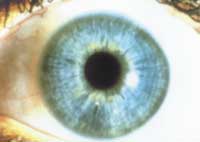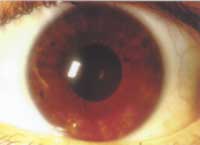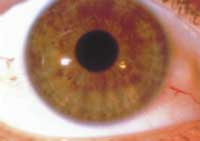Positive Health Online
Your Country

Iridology and the Use of Tissue Salts
listed in vision and eye sight, originally published in issue 59 - December 2000
Have you ever wondered why people have different coloured eyes? No doubt there is some evolutionary theory that could explain this, but to practitioners of iridology it is of great significance.
Iridologists can classify people into specific constitutional groups purely by observing the colour of the iris. This can be done with the naked eye but a more reliable estimation of the colour of an iris can be done under magnification. Of course an iris examination does involve looking at the eye in detail taking into account many different markings and pigments in the iris.

A Lymphatic Iris

A Haematogenic Iris

A Biliary (mixed) Iris
This allows an iridologist to identify weak areas of health which may have occurred in the past, what may be happening at the moment and what could manifest in the future. The constitutional groups can have an influence at any time during an individual's life.Iridologists throughout the world generally agree that there are three base constitutional groups and that each group has a predisposition to particular health weaknesses. There are only three colours of eyes; blue, brown and hazel (a mixture between blue and brown). You may have seen people with green eyes, this represents a base blue iris with a yellow pigment over the top, so blue + yellow = green; the yellow pigment is a significant sign to iridologists.
Deck[1] has clearly shown that a bright blue iris is associated with weaknesses concerning the lymphatic system (see Figure 1). So blue-eyed people may be more prone to conditions like troublesome hyperplasia of the tonsils in childhood, arthritis and rheumatoid illnesses, disorders of mucous membranes and allergies and sensitivities. All of these areas of health weakness show either an overactive or underactive lymphatic system. The more blue the iris the stronger the possibility of a lymphatic weakness.
| Table 1: The twelve tissue salts | |||
| Name | Latin name | Mineral name | Formula |
| Calc fluor | Calcarea fluorica | Calcium fluoride | CaF2 |
| Calc phos | Calcarea phosphorica | Calcium phosphate | Ca3(PO4)2 |
| Calc sulph | Calcarea sulphuricum | Calcium sulphate | CaSO4 |
| Ferr phos | Ferrum phosphate | Iron phosphate | FE3(PO4)2 |
| Kali mur | Kali muriaticum | Potassium chloride | KCl |
| Kali phos | Kali phosphoricum | Potassium phosphate | K2HPO4 |
| Kali sulph | Kali sulphurica | Potassium sulphate | K2SO4 |
| Mag phos | Magnesium phosphorica | Magnesium phosphate | MgHPO4.12H2O |
| Nat mur | Natrum muriaticum | Sodium chloride | NaCl |
| Nat phos | Natrum phosphoricum | Sodium phosphate | Na2HPO4.10H2O |
| Nat sulph | Natrum sulphuricum | Sodium sulphate | Na2SO4.10H2O |
| Silica | Silicea | Silicon dioxide | SiO2 |
Dark brown-eyed individuals (Figure 2) fall into the haematogenic constitution. As the classification name suggests health weaknesses mainly concern disorders of blood and in addition the ability to retain trace elements becomes poor. Deck also suggested that lymphatic cancer (Hodgkin's disease) and easy formation of renal calculi can be associated with dark brown eyes.
Between the above two lies the biliary or mixed constitution (Figure 3). The colour of the eye associated with this constitution will initially appear hazel or light brown, but on closer inspection, usually under magnification, blue fibres can be seen beneath. Again the name of this constitution suggests health weaknesses associated particularly with the liver and gallbladder and to a lesser degree the digestive system as a whole.
Each constitutional group has subgroups that tend to show predisposition to particular kinds of conditions. Altogether there are ten separate subgroups that have been identified. In addition to constitutional identification there are also many different iris signs (about 200) that can pinpoint the locus of a disease process, occasionally the aetiology and can show what physiological reactions are taking place. All go some way to decide what kind of treatment is most suitable.
One of the advantages of iridology is that by identifying the constitutional group of an individual it allows an insight into areas of health weakness that may manifest in the future. So advice can be given to change lifestyle, diet etc. and, if there are early symptoms of constitutional weakness, an effective treatment can be used to bolster each constitution.
One treatment that perhaps fits in extremely well with the constitutional theory is the use of the homeopathically-prepared twelve tissue salts.
Homeopathic tissue salts were first introduced by Dr Schussler in 1873. He realized that human physiological mechanisms necessitated the use of inorganic chemicals and that these chemicals varied in amounts in different types of tissue and deficiencies occurred in different medical conditions.
Dr Schussler identified twelve tissue salts, which are usually known by their abbreviated Latin name. Table 1 lists each tissue salt together with the full Latin name, the chemical name and formula.
Most healthy individuals have a store of all twelve tissue salts, but with illness, stores become depleted quickly. So the simple answer is to replenish the store as soon as possible to help readjust the deficiency. However, once a disease process takes hold, diffusion across a cell membrane becomes very inefficient; therefore the success of tissue salt treatment depends on the timing – the sooner the better. Tissue salts have to be used in low attenuation. This helps the body by supplying the basic salt in its readily available form so that it can be assimilated through the cell membrane with ease.
So does this apply to constitutional treatment? Yes it does. Throughout our lives we all go through different life events that may cause anxiety, stress and tension; all precursors to ill health that can show physically, physiologically and psychologically. So for instance, a person who has bright blue eyes, thereby classified into the lymphatic constitutional group, already has a predisposition to various aspects of health weakness, in particular allergies. The anxiety or stress suppresses the lymphatic system and makes the allergic response more severe. Constitutional tissue salt treatment can be used as a preventative prior to an anticipated stressful event and likewise in the recovery period afterwards. The stressful event can be anything from an exam, to a major surgical operation, to moving house. All are profound events that can affect our lives and bodies considerably.
Effective tissue salt prescribing does require a detailed knowledge of all the constitutional groups and subgroups and the areas of action each tissue salt has. Table 2 gives a brief guide to each tissue salt and its main area of action, which may help practitioners to integrate this system into current treatment methods.
| Table 2: The main areas of action of the twelve tissue salts | |
| Tissue Salt | Area of Action |
| Calc fluor | Muscles, bones (especially connective tissue), teeth, skin and immunity |
| Calc phos | Bones, teeth, blood, gastric juices, mucous membranes |
| Calc sulph | Blood, mucous membranes, skin |
| Ferr phos | Immunity, blood |
| Kali mur | Mucous membranes, skin, nervous system |
| Kali phos | Brain and nervous system |
| Kali sulph | Skin, vascularization of all tissues |
| Mag phos | Nervous system (especially motor nerves), heart, energy levels |
| Nat mur | Blood, mucous membranes, interstitial fluid, gastric secretions |
| Nat phos | Liver and gall bladder, helps eliminate uric acid, lymphatic system |
| Nat sulph | Interstitial fluid removal, pancreas, liver and gall bladder, nervous system (especially the autonomic nervous system) |
| Silicea | Immunity, periosteum, nervous system |
Tissue salts are useful in that they can be used singularly or in combinations, so depending on what symptoms are expected or present, different tissue salts can be mixed to 'tailor-make' the remedy for an individual.
Generally low attenuations are used in the decimal potency, usually 12x. Drop form medication allows easy mixing of the required tissue salts. The dose recommended is two drops placed under the tongue every two to three hours during the day.
The close similarities between the health weaknesses of the constitutional groups and the main areas of action of the tissue salts can be matched with ease. A lymphatic constitution would need a combination of Calc fluor, Calc phos and Ferrum phos. The heamatogenic constitution would be improved by a mixture of Ferrum phos. and Nat mur, and biliary constitutional treatment requires Nat mur, Nat phos and Nat sulph.
Matched tissue salt treatment with iris constitutional types has many uses. Firstly, as mentioned before, it can be used to help support a particular constitutional type before and after times of stress and tension. This helps in the prevention of physical and physiological dysfunction and also speeds the recovery of an illness associated with constitutional weaknesses and reduces complications. It has also been noticed that in cases where treatment, by whatever means, is not successful, by giving the correct iris constitutional tissue salts it provides sufficient impetus to allow other treatments to become more effective. Likewise, treatments that start to work and then reach a plateau often benefit from the 'kick-start' of an iris constitutional tissue salt combination remedy.
You may be asking yourself how efficacious is this theory. Well, research has been started to try and establish the link between iris constitutional types and their respective tissue salt treatment. To date, very early observations from dual iridology/tissue salt practitioners are suggesting a trend that is certainly worthy of further investigation.[2]
Iridology has shown time and time again that there is too much circumstantial evidence for it to be ignored, especially in light of the fact that all iris evaluations are carried out before any medical or surgical case history has been taken and are usually very accurate in their findings. Also, moves are afoot to back up iris findings with common clinical tests like urine testing and blood examination etc. This will help in the attempted validation of iridology providing hard evidence that iridology is a worthy method of health analysis.
There are now international links between various iridology organizations. These links are particularly strong between the UK, Italy, Greece and the USA. Now collective research can be shared and evaluated which will lead to a greater validation of the science of iridology.
Likewise, homeopathic tissue salts have stood the test of time for over 120 years. There are countless cases that have been reported worldwide where tissue salts have been the only form of treatment that has been successful. It is a shame that most research into efficacy of treatments is largely bound up with finance from large pharmaceutical companies. Presumably, they have no profit motive in the development of natural and complementary medicines. However, public demand for such medicines gives some indication as to whether they provide effective forms of treatment.
The marriage of iridology and homeopathic tissue salts is not the end. After all, if tissue salts work, is it possible that other classical homeopathic remedies can work in the same manner? Likewise, are there acupuncture points, reflexology zones, vitamins and minerals, etc., that can also be integrated into this way of thinking? Only time will tell after many studies and investigations to provide the required evidence.
Reference
1. Deck J. Principles of Iris Diagnosis. Institute for Fundamental Research in Iris Diagnosis. Ettlingen. Germany. 1982.
2. Pearson J. Pilot Study – Efficiency of Tissue Salts in Relation to Constitutional Iris Types. In Progress.
Comments:
-
Jake said..
This was written in 2000. What is the update on your reference
2. Pearson J. Pilot Study – Efficiency of Tissue Salts in Relation to Constitutional Iris Types. In Progress.
Has this study been completed? If so where can I find a copy, if not where did you get this refence from?